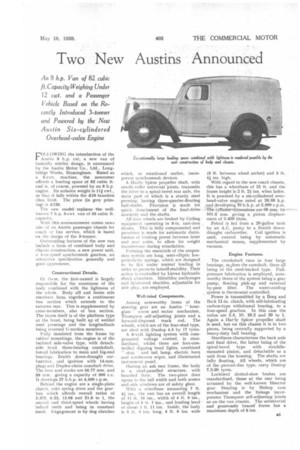Two New Austins Announced An 8 h.p. Van of 82
Page 35

If you've noticed an error in this article please click here to report it so we can fix it.
cubic ft.CapacityWeighing Under 1 2 cwt. and a Passenger Vehicle Based on the Recently Introduced 3-tonner and Powered by the New Austin Six-cylindered
Overhead-valve Engine
FOLLOWING the introduction of the Austin 8 h.p. car, a new van of basically similar design, is announced by the Austin Motor Co., Ltd., Longbridge Works, Birmingham. Rated as a 6-cwt. machine, the newcomer affords a loading space of 82 cubic ft. and is, of course, powered by an 8 h.p. engine. Its unladen weight is 111 cwt., so that it falls within the £10 taxation class limit. The price (in grey priming) is £120.
The new model replaces the wellknown 7 h.p. 5-cwt. van of 55 cubic ft. capacity.
With this announcement comes news also of an Austin passenger chassis for coach or bus service, which is based on the design of the 3-tonner.
Outstanding features of the new van include a form of combined body and chassis construction, a new power unit, a four-speed synchromesh gearbox, an attractive specification generally and good appearance.
Constructional Details.
Os these, the first-named is largely responsible for the roominess of the body combined with the lightness of the whole. Body sill and frame side members form together a continuous box section which extends to the extreme rear, This is supplemented by cross-members, also of box section. The frame itself is of the platform type at the front, being built up of welded steel pressings and the longitudinals being reversed if-section members.
Fully insulated from the frame by rubber mountings, the engine is of the inclined side-valve type, with detachable head, three-bearing crankshaft, forced lubrication to main and big-end bearings, Zenith down-draught carburetter, coil ignition with 14-mm. plugs and Duplex-chain camshaft drive. The bore and stroke are 56.77 mm. and 89 mm.. giving a capacity of 900 c.c. It develops 27 b.h.p. at 4,400 r.p.m.
Behind the engine are a single-plate clutch, with spring drive and the gearbox which affords overall ratios of 5.375, 8.23, 13.08 and 21.6 to 1, the second and third-speed wheels having helical teeth and being in constant mesh. Engagement is by dog clutches which, as mentioned earlier, incorporate synchromesh devices.
A Hardy Spicer propeller shaft, with needle-roller universal joints, transmits the drive to a spiral-bevel rear axle, the main part of which is a sturdy steel pressing, having three-quarter-floating half-shafts. Provision is made for quick detachment of the final-drive assembly and the shafts.
All four wheels are braked by Girling equipment operating in 8-in. cast-iron drums. This is fully compensated and provision is made for automatic distribution of braking .power between front and rear axles, to allow for weight transference during retardation.
Forming the essentials of the suspension system are long, semi-elliptic lowperiodicity springs, which are designed to be flat under normal loading in order to promote lateral stability. Their action is controlled by Luvax hydraulic shock absorbers. Silentbloc anchorages and lubricated shackles, adjustable for side play, are employed.
Well-tried Components.
Among noteworthy items of the steering gear are an Austin " hourglass " worm and sector mechanism, Thompson self-adjusting joints and a forward-disposed track rod. The wheels, which are of the four-stud type, are shod with Dunlop 4.5 by 17 tyres.
A 6-volt lighting system with compensated voltage control, is standardized, whilst there are foot-controlled clipping head lights, combined " stop ' and tail lamp, electric horn and windscreen wiper, and illuminated instrument panel. Flaying an ash rear frame, the body is a steel-panelled structure, with boarded floor. The two-piece door opens to the full width and both screen and side windows are of safety glass.
With a wheelbase measuring 7 ft. 41 ins., the van has an overall length of 11 ft. 10 ins., width of 4 ft. 9 ins., height of 5 it. 7 ins., and loading level of about 1 ft. 11 ins. Inside, the body is 5 ft. 3 ins. long, 4 ft. 6 ins. wide
(3 ft. between wheel arches) and 3 ft. 41 ins. high.
With regard to the new coach chassis, this has a wheelbase of 15 ft. and the frame height is 2 ft. 21 ins, when laden. It is powered by a six-cylindered overhead-valve engine rated at 26.88 h.p. and developing 70 b.h.p. at 2,800 r.p.m.
--the cyThielerediinensions are-85 mm. 101.6 mm. giving a piston displacement of 3.459 litres.
, Petrol is fed from a 20-gallon tank by an A.C. pump to a Zenith down draught carburetter. Coil ignition is used, control being by automatic mechanical means, supplemented by vacuum.
Engine Features.
The crankshaft runs in four large bearings, asiloes the camshaft, these all being of the steel-backed type. Fullpressure lubrication is employed, noteworthy items of the system being a gear pump, floating pick-up and external by-pass filter. The water-cooling system is thermostat controlled.
Power is transmitted by a Borg and Beck 11-in, clutch, with self-lubricating carbon-type withdrawal bearing, to a four-speed gearbox. In this case the ratios are 5M, 10, 19.2 and 39 to 1. Again a Hardy Spicer propeller shaft is used, but on this chassis it is in two pieces, being centrally supported by a heavy-duty ball bearing.
Sturdiness characterizes the back axle and final drive, the latter being of the spiral-bevel type with straddlemounted pinion, and detachable as a unit from the housing. The shafts are fully floating. All wheels, which are of the pierced-disc type, carry Dunlop 7.5-20 tyres.
Lockheed slotted-shoe brakes are standardized, those at the rear being actuated by the well-known Bisector gear. Steering is by Bishop cam mechanism' and the linkage incorporates Thompson self-adjusting joints as on the van chassis. The substantial and generously braced frame has a maximum depth of 8 ins.




















































































